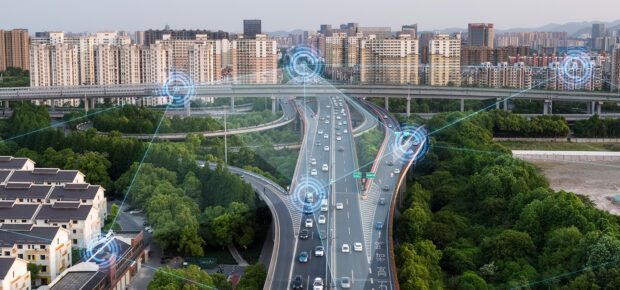January 25, 2022
Roads, bridges, dams and train lines. Schools and streetlights. For decades, infrastructure has been made of concrete, asphalt and steel.
Increasingly, however, infrastructure is built with digital technologies. The goal: to make traditional infrastructure safer, more sustainable and more efficient.
Consider some recent examples: energy usage by the City of San Diego, Calif. dropped by 60% when LED streetlights were paired with sensors that respond to light, sound and other signals. In Arizona, thermal cameras and warning signals prevented more than a dozen wrong-way drivers from entering highways in 2018. Residents of California are now the beneficiaries of an early warning system for earthquakes that gives them crucial time to get to safety.
And in New York, the newly completed replacement for the Tappan Zee Bridge includes more than sensors that monitor structural conditions like cable strain, temperature, fatigue and corrosion. Other sensors monitor road conditions in harsh weather, while another set manages LED lighting on the bridge.
“Digital transformation adds a new technological layer to existing infrastructure thereby enabling data to be transmitted in a standardized way,” said IEEE Senior Member Preethy Warrier.
Here’s a look at other ways that physical infrastructure is undergoing a digital transformation:
A sustainable electricity grid
Electricity grids are some of the largest pieces of infrastructure on the planet. They’re being upgraded to account for more renewable energy.
The share of renewables in global electricity was 29% in 2020, up from 27% in 2019, according to the International Energy Agency. And 80% of new energy capacity added in 2020 came from renewable sources, according to the International Renewable Energy Agency. But renewable energy sources are also intermittent power sources. The sun doesn’t provide power 24 hours per day, and some of the windiest periods are overnight, when demand is lowest.
“More sensors and methods of collecting data are emerging, creating many opportunities to use this data to enhance the design and operation of infrastructure,” said Kyri Baker, IEEE member. “In the power grid, for example, these sensors can help pinpoint outages and predict issues before they occur, possibly avoiding large-scale blackouts. Historical data that has been collected throughout the grid can help grid operators determine where upgrades might be needed, or when a piece of equipment is likely to fail.”
Instant pothole reporting
5G provides great opportunities for collaborative perception from a network of vehicles without the need for extra sensors on the road. This could be useful for autonomous vehicles. But it might also be useful for predictive maintenance of roadways. In other words, your car might report potholes before they form.
5G allows vehicle sensor data and vehicle motion to be sent to a central server for use on determining road and infrastructure problems and for later maintenance,” said Bilin Aksun-Guvenc, IEEE member. “The same tools can be used to guide road users to optimize the load on the roads such that they last longer.”
Optimized with digital twins
A digital twin is a virtual model of a real-world object, machine or system that can be used to assess how its real-world counterpart is performing. Digital twins can diagnose and predict faults, or simulate how future changes could alter its behavior. Typically, a digital twin involves both a digital simulation and live sensor data from the real world system to keep the model up to date.
Sound complex? Think of it this way: in a port, operators have forklifts, ships and shipping containers. A digital twin might use sensors on all of these assets to build a model of the port’s operations. It might also integrate that model with weather data, or information about currents and silt depth in waterways. Data from the sensors can then be analyzed using artificial intelligence and machine learning to optimize operations. Digital twins can be applied to ports, bridges, roadways and other types of infrastructure.
What remains to be seen is the degree to which the digital technologies that are improving infrastructure are integrated into more comprehensive systems. What’s clear, however, is that these projects are forming the building blocks of the smart cities movement.
Many of the digital upgrades to physical infrastructure have their roots in smart cities technology. If you’d like to learn more about smart cities, and how IEEE standards are helping to make these complex systems a reality, check out this comprehensive review.





 Meaningful Momentum or Running in Place?
Meaningful Momentum or Running in Place? AI Through Our Ages
AI Through Our Ages Liquid Infrastructure: Our Planet's Most Precious Resource
Liquid Infrastructure: Our Planet's Most Precious Resource The Impact of Technology in 2025
The Impact of Technology in 2025 Quantum and AI: Safeguards or Threats to Cybersecurity?
Quantum and AI: Safeguards or Threats to Cybersecurity? Why AI Can't Live Without Us
Why AI Can't Live Without Us Bits, Bytes, Buildings and Bridges: Digital-Driven Infrastructure
Bits, Bytes, Buildings and Bridges: Digital-Driven Infrastructure Impact of Technology in 2024
Impact of Technology in 2024 Emerging AI Cybersecurity Challenges and Solutions
Emerging AI Cybersecurity Challenges and Solutions The Skies are Unlimited
The Skies are Unlimited Smart Cities 2030: How Tech is Reshaping Urbanscapes
Smart Cities 2030: How Tech is Reshaping Urbanscapes Impact of Technology 2023
Impact of Technology 2023 Cybersecurity for Life-Changing Innovations
Cybersecurity for Life-Changing Innovations Smarter Wearables Healthier Life
Smarter Wearables Healthier Life Infrastructure In Motion
Infrastructure In Motion The Impact of Tech in 2022 and Beyond
The Impact of Tech in 2022 and Beyond Cybersecurity, Technology and Protecting Our World
Cybersecurity, Technology and Protecting Our World How Technology Helps us Understand Our Health and Wellness
How Technology Helps us Understand Our Health and Wellness The Resilience of Humanity
The Resilience of Humanity Harnessing and Sustaining our Natural Resources
Harnessing and Sustaining our Natural Resources Creating Healthy Spaces Through Technology
Creating Healthy Spaces Through Technology Exceptional Infrastructure Challenges, Technology and Humanity
Exceptional Infrastructure Challenges, Technology and Humanity The Global Impact of IEEE's 802 Standards
The Global Impact of IEEE's 802 Standards Scenes of our Cyber Lives: The Security Threats and Technology Solutions Protecting Us
Scenes of our Cyber Lives: The Security Threats and Technology Solutions Protecting Us How Millennial Parents are Embracing Health and Wellness Technologies for Their Generation Alpha Kids
How Millennial Parents are Embracing Health and Wellness Technologies for Their Generation Alpha Kids Space Exploration, Technology and Our Lives
Space Exploration, Technology and Our Lives Global Innovation and the Environment
Global Innovation and the Environment How Technology, Privacy and Security are Changing Each Other (And Us)
How Technology, Privacy and Security are Changing Each Other (And Us) Find us in booth 31506, LVCC South Hall 3 and experience the Technology Moon Walk
Find us in booth 31506, LVCC South Hall 3 and experience the Technology Moon Walk Virtual and Mixed Reality
Virtual and Mixed Reality How Robots are Improving our Health
How Robots are Improving our Health IEEE Experts and the Robots They are Teaching
IEEE Experts and the Robots They are Teaching See how millennial parents around the world see AI impacting the lives of their tech-infused offspring
See how millennial parents around the world see AI impacting the lives of their tech-infused offspring Take the journey from farm to table and learn how IoT will help us reach the rising demand for food production
Take the journey from farm to table and learn how IoT will help us reach the rising demand for food production Watch technical experts discuss the latest cyber threats
Watch technical experts discuss the latest cyber threats Explore how researchers, teachers, explorers, healthcare and medical professionals use immersive technologies
Explore how researchers, teachers, explorers, healthcare and medical professionals use immersive technologies Follow the timeline to see how Generation AI will be impacted by technology
Follow the timeline to see how Generation AI will be impacted by technology Learn how your IoT data can be used by experiencing a day in a connected life
Learn how your IoT data can be used by experiencing a day in a connected life Listen to technical experts discuss the biggest security threats today
Listen to technical experts discuss the biggest security threats today See how tech has influenced and evolved with the Games
See how tech has influenced and evolved with the Games Enter our virtual home to explore the IoT (Internet of Things) technologies
Enter our virtual home to explore the IoT (Internet of Things) technologies Explore an interactive map showcasing exciting innovations in robotics
Explore an interactive map showcasing exciting innovations in robotics Interactively explore A.I. in recent Hollywood movies
Interactively explore A.I. in recent Hollywood movies Get immersed in technologies that will improve patients' lives
Get immersed in technologies that will improve patients' lives